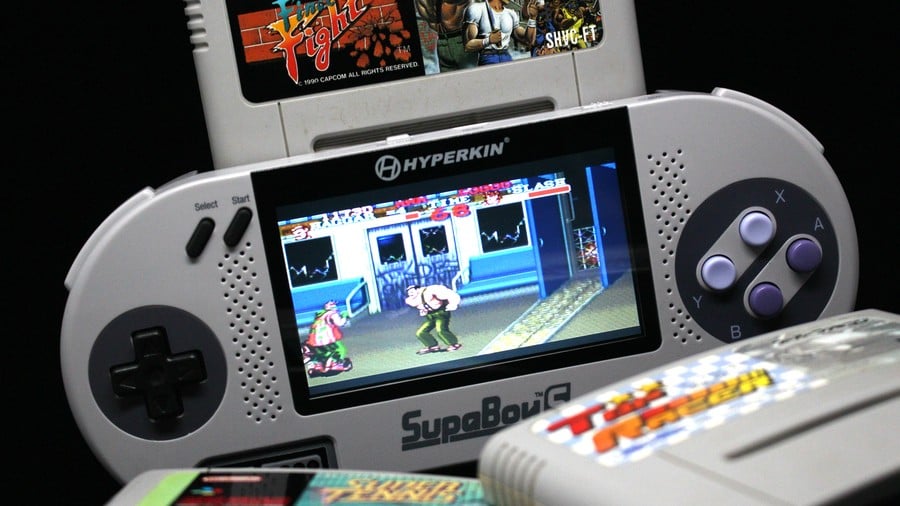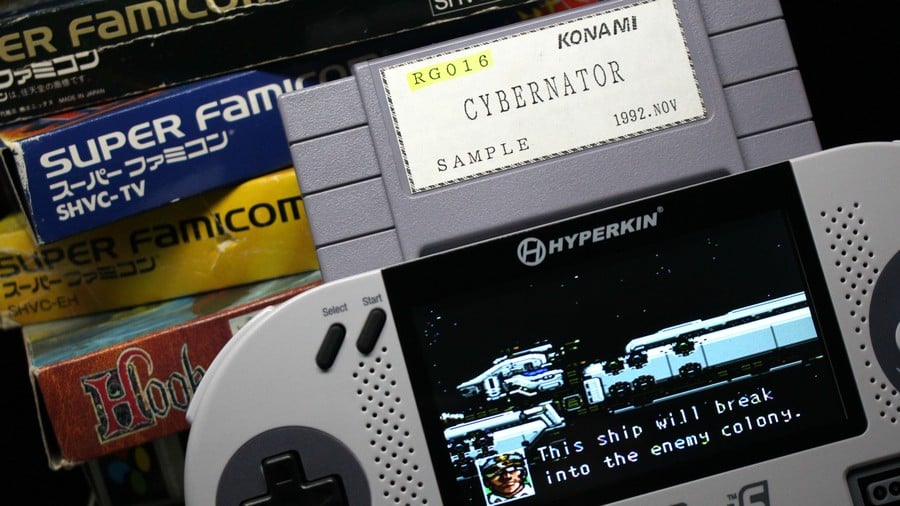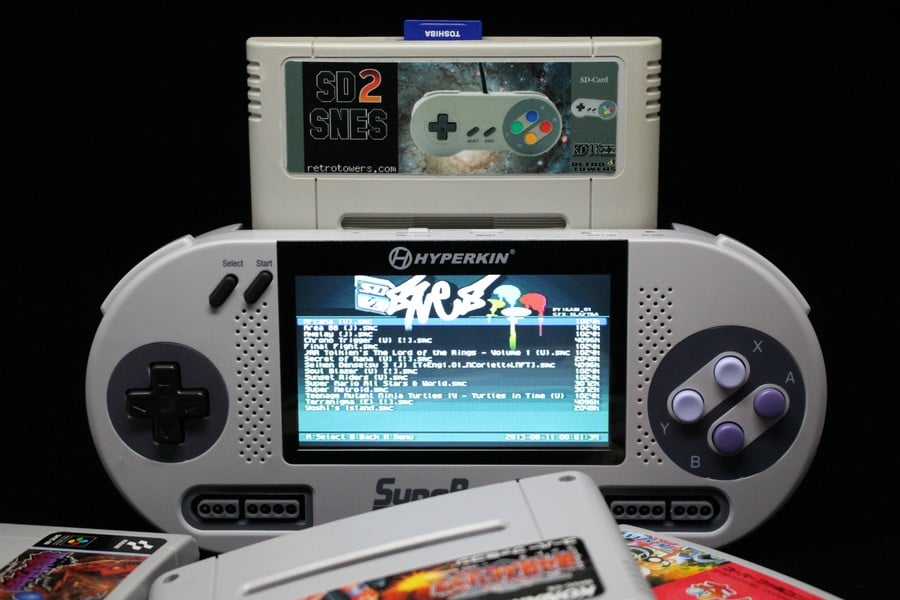
The industry's passion for "new" retro hardware has been growing steadily over the past few years, and the launch of the NES Classic Mini finally signals Nintendo's entry into this niche yet vibrant sector of the market. Given the astonishing success of that venture it is almost inevitable that we'll see a SNES Classic Mini at some point in the future, but until then there are plenty of unofficial options if you want to give your 16-bit software a new lease of life.
One company which has been very active in this sector is Hyperkin. Responsible for the Retron series of multi-format consoles - of which the Retron-5 is the most recent - Hyperkin also produced the SupaBoy in 2012, a portable take on the SNES which we found to be very agreeable, build-quality issues aside. The concept was clearly a winner with consumers too, as Hyperkin has now released an updated edition of the device dubbed the SupaBoy S. Upgrades include support for PAL carts, an improved display and a longer-lasting battery, but are these compelling enough reasons to replace your existing SupaBoy, and is this machine still worthy of a recommendation in 2016? We're about to find out.
Portable Power, But Not Pocket-Sized
Simply put, this is a portable clone of the SNES console, but don't go expecting something of Game Boy Micro proportions - this is one chunky beast. It has a 4.3-inch LCD screen, stereo speakers, a 3.5mm headphone socket, TV-out and full physical controls. It also boasts two controller ports so when it's in TV-out mode it can operate like a traditional console. There's a cartridge slot on the top which accepts Japanese, North American and PAL SNES games, and on the upper edge there's a switch which allows you to toggle your region, as well as a reset button. On the bottom edge there's a volume dial and brightness button. In the box you get a Micro USB cable for charging, a lanyard and a composite TV-out lead, as well as a cloth bag to store the console in when it's not in use.
From a physical perspective, the SupaBoy S is an almost exact match to the original design. The size is an issue, but it's not all that shocking when you consider that it's running SNES cartridges which are many times bigger than a 3DS or even Game Boy cart - it's also very comfortable to boot. You don't get cramped fingers because there's plenty of plastic to grip onto, and the D-Pad and buttons all feel tight and responsive. From an interface stance, this is as good as you can really expect from a non-official product.

Hyperkin has made quite a big deal about the improved screen on the SupaBoy S, but in reality it's something of a mixed blessing. The display on the original system was merely passable; colours looked washed out and it lacked definition, but it wasn't a deal-breaker back in 2012. On the newer model the screen is brighter and more vivid, but the aspect ratio is widescreen - the earlier version had a 4:3 ratio which was in tune with the TV output of the SNES itself. Annoyingly, there doesn't seem to be any way of forcing the console to revert to the correct 4:3 ratio, which means everything looks stretched and a little odd.
Why Hyperkin has decided to take this route is anyone's guess, but screens with a 4:3 ratio will no doubt be harder to source these days given that manufacturers of such displays will be focused almost entirely on the smartphone sector. However, other solutions exist; the 4.3-inch screen could have been forced to display the correct 4:3 ratio with the blank sections of the display covered by the casing to keep them from view (Nintendo performs a similar trick with the 2DS, which has a single screen, not two).

Whether or not Hyperkin will choose to enable a 4:3 aspect ratio on future revisions remains to be seen, but at the moment this is the single biggest issue with the SupaBoy S. Those fond of emulation will attest that SNES games look amazing when displayed on a pixel-perfect screen with bold colours, and it just doesn't seem right that in 2016 we still can't get a handheld clone with a perfect screen. It's possible to play your games as nature intended by using the TV-out functionality - my HDTV has a feature which forces a 4:3 aspect ratio - but the composite connection is muddy and ill-defined, as is to be expected.
Elsewhere, the changes are definitely for the better. The battery life has increased dramatically over the rather pathetic two-and-a-half hours seen in the first SupaBoy, although we've not yet been able to achieve the 10 hours quoted by Hyperkin on the box. Still, it's a massive improvement and unquestionably one of the big plus points to the SupaBoy S upgrade. The introduction of a region switch is also welcome, and allows you to get around the territory locks which were introduced later on in the lifespan of the console. As a bonus, the SupaBoy S also supports the Super Game Boy perherphal, as well as flash carts like the SD2SNES - something that many clone systems don't offer. Super FX games like Star Fox and Stunt Race FX also run flawlessly on the console.
Conclusion

The SupaBoy S is a case of two steps forward, one step back. While the screen is better and the console now has multi-region support and enhanced stamina, the widescreen aspect ratio means you're not seeing SNES games as you remember them from back in the day, and the LCD display used isn't anywhere near the standard you'd see on systems like the 3DS or PS Vita. When we reviewed the original SupaBoy we argued that it was perhaps unrealistic to expect a high-quality screen on such a cheap device, but almost four years on and display tech has continued to plummet in price, so that excuse holds less water. It's a real shame that Hyperkin wasn't able to include a higher quality screen; $99.99 / £99.99 isn't chump change in anyone's book, after all.
While it has its shortcomings, the SupaBoy S is still the best option for SNES fans who want to play their cartridges on the go. Admittedly that's a rather narrow subset of Nintendo gamers and there are other options available for this kind of thing, the most obvious being the Virtual Console on the New Nintendo 3DS, but the SupaBoy S still neatly fills a niche in the market - assuming you can live with that stretched screen, of course.

Thanks to Funstock for supplying the Hyperkin SupaBoy S used in this review.





Comments 26
A shame, the screen ratio is a deal breaker for me... hope they do revise it in the future.
Like the article mentioned...why not just add black bars to the sides to preserve the 4:3 (or at least the option to do so)? Seems like an oversight there Hyperkin.
What a terrible decision that screen is. Absolutely no interest with that.
DIY Retropie remains the best option fro classic gaming, even if it is naughty. I really wish someone would come up with a great legit option.
This looks cool where can I order one? I have around 35 - 40 SNES carts in my loft just waiting to be shown some love
I have the original Supaboy and I love it, but I was hoping the new S version would give me a good reason to upgrade. Specifically they should have added an HDMI port. As it is I can't justify the upgrade, especially since the aspect ratio is actually a step back.
No 4:3 support means no purchase by me.
@Marios-love-child you can get it here: http://www.funstockretro.co.uk/supaboy-s-portable-console
@andyfunstock
thank you
Instead of making this, they could had made us an N64 portable clone, I would buy that one instead. The original SupaBoy had its flaws like the short battery life but its screen and control were okay and you could always find converter if you want to play PAL games on it so I see no reason for them to revise this one. I also don't see how they could screw up the screen aspect ratio like that nor do I know why they choose to do that to begin with.
Perhaps the only real reason I could see someone buying this is if they wanted to play PAL games on it or lives in PAL territories. Also by introducing a 16:9 aspect ratio presentation, one would think that they'll support HDMI video output which would be the best suitable upgrade for that $99 price point but nope you still get the usual composite output through AV, no S-Video, no RGB for PAL, and no HDMI. Sorry Hyperkin this product was a disappointment.
Does anyone know if you can apply translation patches so that I can play my super famicom carts in english? I think retron can do that so maybe this can too? (could the original SupaBoy do that?)
@speedracer216 Nope, you could only do that through emulation, this is a clone on a chip device and it handles game as if they were play on an actual console. If you had a repro that is already translated into English like Secret of Mana 2 and Clock Tower you could play them on this though.
@andyfunstock it says guaranteed pre-Christmas delivery. Is that for the US too?
Thanks!
@hippoeater unfortunately not. If you do really need it before Christmas I suspect you could probably even pick this up cheaper locally? Amazon US are showing it in-stock at $99.99 (currently £81.07). Hope this helps!
Hot garbage.
Is there absolutely no way to change the screen settings?
What if some people don't like black bars? I sure as heck don't like them on my Snes games, this'd be perfect for me, and with SD2Snes, well heh, patched English games are feasible, and on the go.
What have you done?!! As a result of seeing this review I immediately purchased one of these systems from Amazon! I woke up today blissfully unaware of how awesome this system is, and then BAM, you changed my whole day, NintendoLife! 😂 Now I can finally fulfill my 25 year long dream of playing my large catalog of Super Nintendo games on a handheld system! (P.S. thank you so much!!!!!!!)
Why the hell would they not allow you to play in the correct aspect ratio? If they couldn't source the screens then just allow a switch or a setting to change it. Weird.
@Shiryu Same. What a blunder.
I agree that the stretching is bad, but believe it or not there are some weird newbies out there that actually love stretching old games to wide ratios. I have been dumbfounded by this myself, but at least that small group will be elated, lol.
Sadly judging by YouTube, it's not such a small group.
Couldnt a future patch fix it? This would be something awesome. In fact this could be the most awesome thing ever for me as a lover of snes games! This is esentially a portable/console Retron 1 using snes, my favorite!
@Priceless_Spork You can't patch this thing cause it doesn't used emulator and doesn't had an operating system built-in. It is a clone on a chip device meaning you play it as if it was an actual SFC/SNES using cartridge and nothing else. If they screw up any design to this system, they had to correct it with another version, it's not like a Retron 5 where you can just patch it with a firmware update.
It's literally a Super Nintendo with a screen & a battery. Think Sega Nomad, but for Super Nintendo.
There's no operating system for patches or adjusting settings. There's nothing for save states.
I don't have a SupaBoy, but I've had two RGPs, which are basically the same thing. I love them. They're great for playing your old carts on the couch. And you can plug it to your TV and put controllers in the ports, and play with your friends.
I'm gonna just stick with my old Supaboy. More expensive and still crappy screen = pass.
@lifepsychedelic Emulators (save for the ones Nintendo makes for its Virtual Console service) generally have sound lag, which makes a lot of homebrew rhythm games extremely difficult to play. Luckily, my hybrid self-built SNES/Super Famicom flash cart does not have that problem. I used an SD card reader from my previous laptop (I had to upgrade from Windows XP to run newer Steam games) as the ROM source and adapted my tablet's tranlator app's code to automatically apply translation patches to Japan-only games on the fly. It took me seven months of hard work and nearly fifty prototypes to get functioning properly. It reads SD cards of up to 2TB (the highest SDXC supports, but those aren't out yet).
Show Comments
Leave A Comment
Hold on there, you need to login to post a comment...